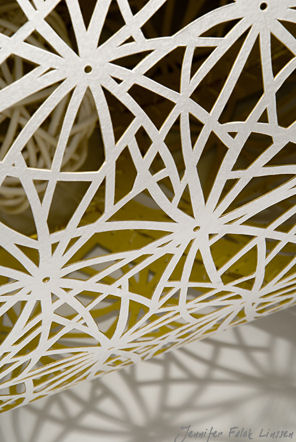
Order and Chaos
©2007
Frequently Asked Questions & Glossary
Katagami
Japanese term - literally "pattern paper"*. It is the paper stencil used in
katazome through which rice paste resist is printed on lengths of kimono cloth.
Katazome
Japanese term - literally "pattern dyeing"*. It is a Japanese printing and
dyeing process that uses stencils (katagami) for printing on fabric.
Generally, a resist made from rice paste is pressed through the stencil onto
the kimono cloth. The cloth is dried and then dye is applied to the fabric.
Once the dye is set, the cloth is rinsed. The water removes the rice paste
resist and the fabric is left covered with designs in dye.
Shifu
Shifu refers to both the handspun paper strands and the cloth that is woven
from it. Shifu is a Japanese process where mulberry (kozo) paper is sliced
into a continuous flat strip, dampened, and then handspun into thread form.
What type of paper do you use and is it archival?
All of the paper I use is archival. The varieties include cotton, abaca, and
mulberry. I use handmade paper in my sculpture - either my own or traditionally made Japanese, Mexican, or American papers depending on the piece. I feel it is
important to keep papermaking alive both in our culture and throughout the
world.
How do you color your paper?
The paper pulp is usually mixed with pigments before forming into sheets. The
sheets of paper are then washed with acrylic colors or dipped into indigo dye
baths. Additional painting work is completed both before and after carving.
Do you really hand carve all of those pieces?
Yes, each piece is handcarved individually with a small knife. A laser is not
used. Even when several pieces look like they have a similar pattern of
carving, they are not layered during carving. Each piece of paper is
individually carved by hand.
The paper appears smooth in some light and textured in others. Why is this?
Because it is handmade, the paper will have texture and surface variation.
Directional lighting can bring out this surface variation. And depending on
what type of paint and indigo dyeing I use, the paper's surface may appear
smooth in some light and textured in others. Also please note that many of my framed
two-dimensional works will have a deckle edge. Pulling each sheet individually
with a deckle and frame creates this textured edge.
I see lines in the paper. Why do they only appear in certain areas?
Crease or fold lines are added to the carved paper with a bookmaker's bone
folder. The lines help the paper curve into specific shapes.
more carved + cut paper terms
Kataezome
Japanese term for pictorial stencil carving.
Kiri-e
Japanese term for cut paper artwork. This type of cut paper is used for
illustrations and fine art, not stencils. Sometimes referred to as Ki ri ga
(kiriga).
Jian zhi
Chinese term for cut paper artwork. Pronounced gee-an jeer.
Chung-hua
Chinese term - literally "window flower." It is jian zhi (cut paper art)
which is traditionally attached to a home's windows for decoration.
Monkiri
Japanese term - literally "crest cut." It refers to the small, often
circular stencil used to dye crests on garments.
Kirigami
Japanese term - literally "cut paper." Kirigami is a form of origami where
small cuts are allowed to form new shapes and objects.
Kiru / Kiri
Japanese term: "to cut" / "cutting."
Washi
Japanese paper.
Scherenschnitte
German term for cut paper artwork... "scissor cuts." Pronounced shear-n-SNIT-a.
Knippen
Dutch term for cut paper artwork. Prononced KNIP-pen.
Wycinanki
Polish term for cut paper artwork. Pronounced vee-chee-NON-kee.
* From one of my favorite books: Carved Paper - The Art of the Japanese Stencil by Susanna Campbell Kuo, edited by Susan Shin-Tsu Tai, Santa Barbara Museum of Art and Weatherhill, Inc., New York & Tokyo, 1998, ISBN 0-8348-0409-3.

